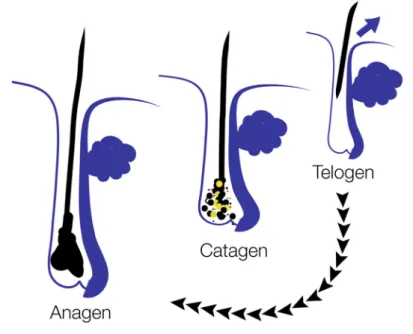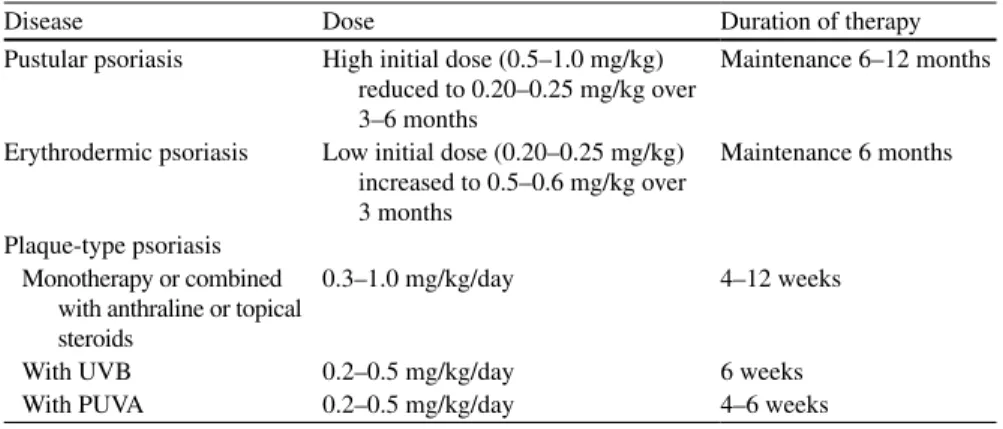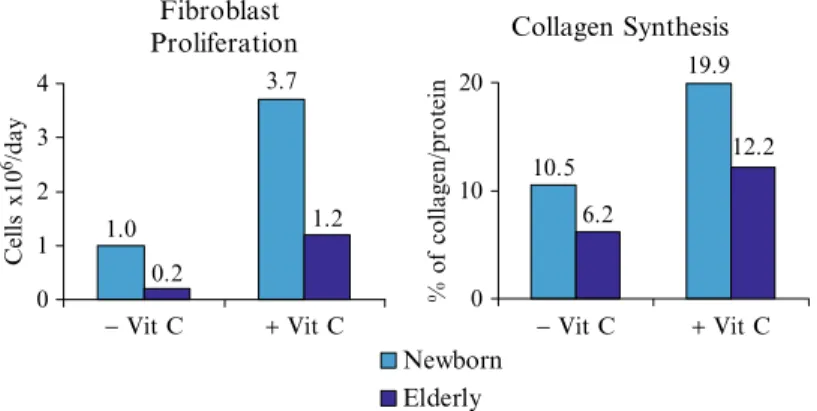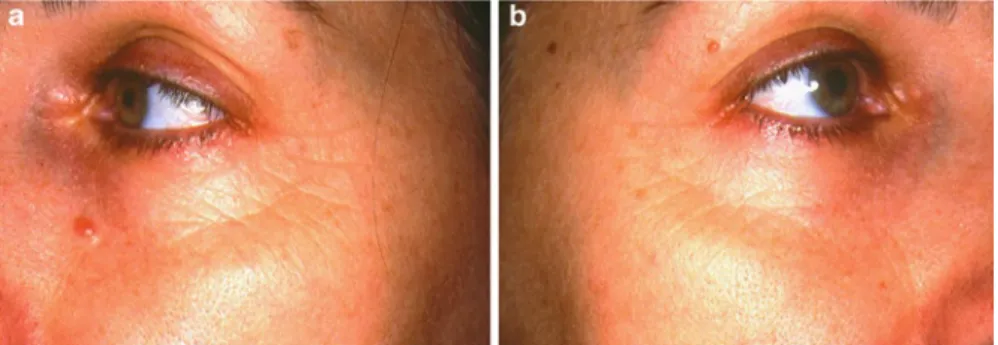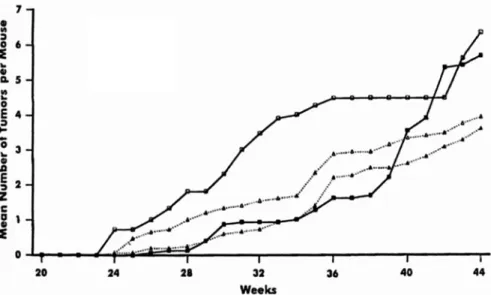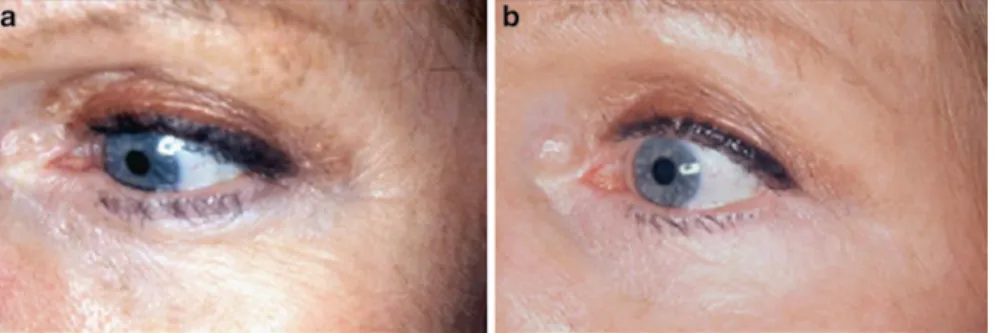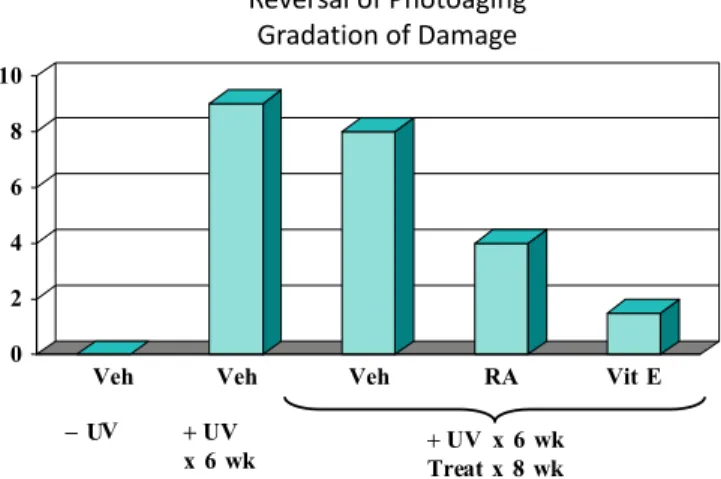Johnson & Johnson Skin Research Center CPPW, a division of Johnson & Johnson Consumer Companies, Inc. All these products are closely related to the health, well-being and needs of the modern consumer.
Introduction and Overview
The focus on the deficiency of certain minerals is discussed along with their association with many skin diseases. Boyle's team focuses on the facts - using direct evidence of their beneficial effects on the skin.
Nutrients and Skin
Core Messages
Introduction
Vitamin A and the Skin
- Naturally Occurring Retinoids
- Synthetic Retinoids
- Absorption, Distribution, and Metabolism
- Mechanism of Action
- Retinoid Receptors and Gene Regulation
- Effect on Epidermal Growth and Differentiation
- Effects on Sebaceous Gland Activity
- Immunomodulatory and Antiinflammatory Properties
- Therapeutic Uses
- Psoriasis and Related Disorders
- Disorders of Keratinization
- Seborrhea, Acne, and Acneiform Disorders
- Retinoids in Skin Cancer
- Chronic Hand Eczema
- Adverse Reactions and Tolerability .1 Mucocutaneous Complications
- Ocular and Neurological Complications
- Serum Lipids, Gastrointestinal Side Effects, Liver Function, and Endocrine Adverse Effects
- Long-Term Toxicity: Bone Changes
- Arthralgias and Myalgias
- Teratogenicity
Re-introduction is recommended after normalization of enzyme levels with 25% of the original dose (Otley et al. 2006). Annual radiography of the ankle or thoracic spine is optional (Otley et al. 2006; Scheinfeld and Bangalore 2006).
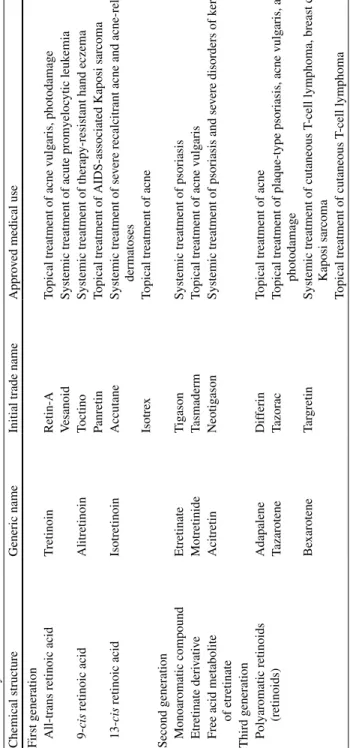
Introduction
Our understanding of the relevance of vitamin D metabolism in human skin has improved significantly in recent years. On the other hand, ultraviolet (UV) exposure is one of the major risk factors for epithelial skin cancer.
Relevance of the Cutaneous Vitamin D Endocrine System for Skin Physiology
Vitamin D Synthesis in Skin
The production of 1,25-(OH)2D3 in the kidney is regulated by a feedback mechanism of the hormone itself, but also by parathyroid hormone, calcium and cytokines such as interferon-g (IFNg) and tumor necrosis factor-a (TNFa). ) (Holick 2007). The metabolism of 1,25(OH)2D circulating in the blood to calcitroic acid is the result of another well-characterized biochemical reaction cascade.
- Inhibition of Proliferation and Induction of Differentiation in Keratinocytes
- Immunmodulatory Effects in the Skin
- Regulation of Apoptosis
- Cytoprotective Effects
- Antioxidative Effects
Furthermore, 1,25-dihydroxyvitamin D3 (10−7 M) was demonstrated to have a photoprotective effect in WST-1 and crystal violet-based assays after irradiation of the keratinocytes with increasing doses of UVB light J/cm2). A significant cytoprotective effect was proven after 48 hours of pretreatment of the cells with 1,25-dihydroxyvitamin D3 at a concentration of 10−7 M (Trémezaygues 2009).
Clinical Studies of Vitamin D and Its Analogues in Psoriasis and Other Skin Diseases
Recently, a randomized, placebo-controlled, double-blind, multicenter study analyzing the efficacy and safety of topical becocalcidiol for the treatment of psoriasis vulgaris has been reported (Helfrich et al. 2007). Recently, the combination of acitretin and oral calcitriol has been reported for the successful treatment of plaque psoriasis (Ezquerra et al. 2007).
Treatment .1 Scalp Psoriasis
- Nail Psoriasis
- Face and Flexures
- Skin Lesions in Children
- Psoriatic Lesions in HIV Patients
- Combination of Vitamin D Analogues with Other Therapies
- Other Skin Disorders with Vitamin D Analogues
- Vitamin D and Ichthyosis
- Vitamin D and Scleroderma
- Vitamin D and Vitiligo
- Vitamin D and Skin Cancer
- Vitamin D and Other Skin Diseases
Other case reports also demonstrated the efficacy and safety of vitamin D analogs in the treatment of psoriasis (Gray et al. 1992). Comparative effects of calcipotriol solution (MC 903) and placebo (MC 903 vehicle) in the treatment of scalp psoriasis.
Introduction
This cumulative damage leads to unattractive premature skin aging and precancerous and cancerous skin conditions. Unfortunately, less than 33% of the population regularly applies sunscreen despite the current increased advertising promoting the need for protection (The Skin Cancer Foundation - Guidelines 2010).
Vitamin C
Exciting studies in vitro compared newborn with aged (80- to 95-year-old) fibroblasts (Phillips et al. 1994). Topical vitamin C has also been shown to increase the synthesis of several specific skin surface sphingolipids (Uchida et al. 2001).
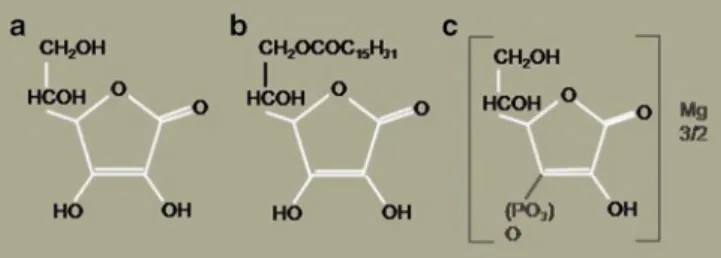
Vitamin E
The results in Table 4.1 (Burke et al. 2000) show that topical d-a-tocopherol inhibits sun blistering by 73% and tanning by 40%. The number of tumors ³2 mm on each mouse was counted and the mean number of tumors per mouse was calculated based on the total number of mice in each treatment group (Burke et al. 2000).

Vitamin C with Vitamin E
Vitamin C with Vitamin E and Ferulic Acid
Unlike vitamins C and E, ferulic acid minimally blocks UVB and acts directly as a sunscreen, as shown in Fig. skin cancer.
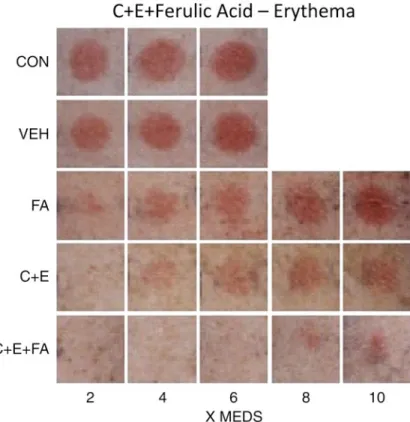
Take-Home Messages
Introduction
Collectively and individually, all layers of the skin work toward the primary goal of protecting internal tissues and vital organs from daily environmental challenges.
Carotenoids and Skin
- Dietary Carotenoids
- Carotenoids Bioavailability and Biodistribution to Skin .1 Carotenoids Bioavailability
- Factors Influencing Carotenoid Bioavailability
- Carotenoids Biodistribution to Skin
- Techniques to Analyze Carotenoids in Skin
- Dietary Carotenoids Protect Skin Against Some of the Damaging Effects of UV Exposure
- Damaging Effects of UV on Skin
- Carotenoids are Scavengers of UV-Induced Reactive Oxygen Species that Damage DNA
- Dietary Carotenoids Reduce Sunburn Development
- Dietary Carotenoids and Skin Cancer
- Future Perspectives on Systemic Photoprotection by Carotenoids
An exception may be the selective delivery of lutein and zeaxanthin to the macular region of the retina by HDL (Connor et al. 2007). Binding of carotenoids to dietary proteins has been shown to reduce their absorption in ferrets (Sundaresan et al. 2005). Parasitemia has generally been negatively correlated with plasma carotenoid concentrations (Metzger et al. 2001).
Synthetic lycopene showed a trend but did not reach statistical significance (Stahl et al. 2006). Human intervention studies with a mixture of carotenoids (ie, b-carotene, lycopene, lutein) confirmed the photoprotective effect of carotenoids (Heinrich et al. 2003).
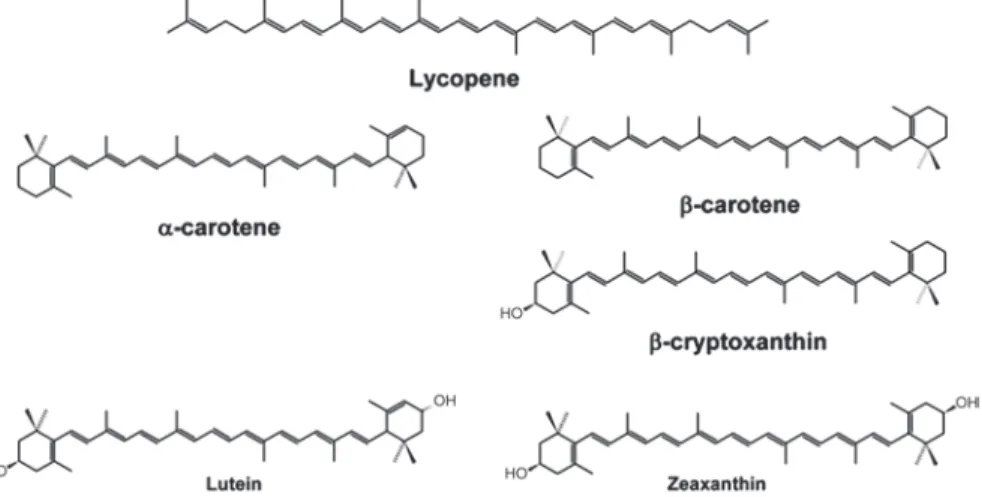
Antioxidants and Skin
- Introduction
- Positive and Negative Effects of Antioxidants
- Polyphenols: Cocoa and Green Tea
- Antioxidants Protect Human Skin from Premature Aging
Antioxidants form protective chains in the human skin and protect each other against the destructive action of free radicals. In this chapter, the results of various studies on the interaction of free radicals and antioxidants, specifically carotenoids, in the human skin are summarized and discussed. Fruits and vegetables contain various antioxidants, which are also found in the human body and, more specifically, in the skin (Darvin et al. 2005b, 2007).
This is because the various antioxidants form protective chains in the human organism and thus protect themselves against the destructive effects of free radicals. Long-term consumption of green tea polyphenol drink increased blood flow in the skin (article in preparation).
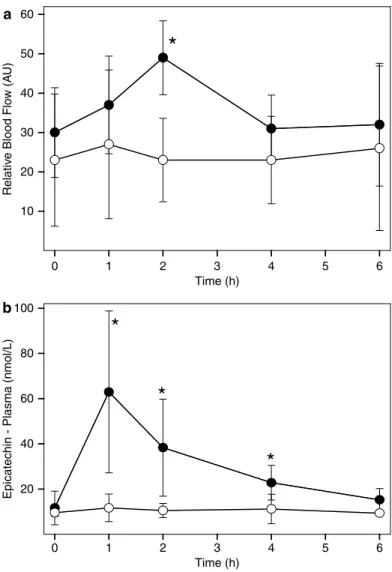
Take Home Messages
Introduction
Although only about 4% of the human body mass is made up of minerals, they play a significant role. Minerals are involved in the maintenance of electrical neutrality, osmotic pressure, solubility, buffer systems, nervous conditions and metabolism via constituents of enzymes; they are also components of bones and teeth (Anke et al. 1999). Minerals are classified as trace elements (each <0.1% of body weight) and major elements (each >0.1% of body weight).
Minerals and the Skin
- Zinc
- Functions
- Deficiency
- Impact on the Skin
- Iron
- Functions
- Deficiency
- Impact on the Skin
- Copper
- Functions
- Deficiency
- Selenium
- Functions
- Deficiencies
- Impact on the Skin
- Chromium
- Functions
- Impact on the Skin
- Silicon
- Functions
- Dietary Recommendation
- Deficiency
- Impact on the Skin
- Introduction
Ingrown nails (so-called Beau's lines) may be seen and attributed to zinc deficiency (Gaveau et al. 1987). Zinc itself may also have an effect beyond antifungal activity: the anti-inflammatory effect may reduce the hyperproliferation of dandruff-prone skin (Schwartz et al. 2005). The main cause appears to be depleted iron stores accompanied by suboptimal intake of the essential amino acid l-lysine (Rushton et al. 2002).
Total body selenium has been estimated to be 5-15 mg in adults (Patterson et al. 1989). Chromium ions are components of the glucose tolerance factor that is important for protein, glucose and lipid metabolism (Anke et al. 1999).
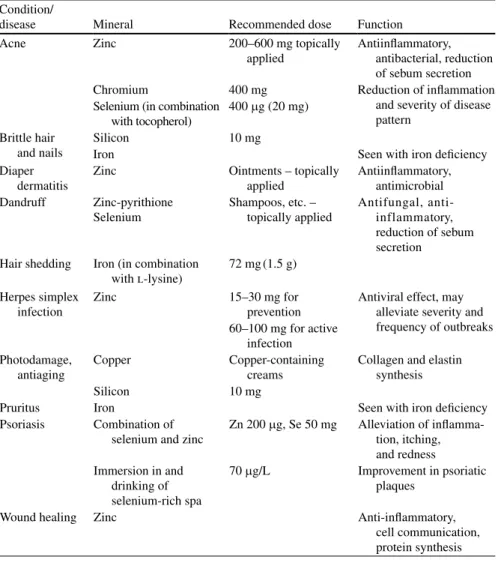
Probiotics and Skin
- Probiotics
- Eczema
- Probiotics for Treating Eczema
- Probiotics for Preventing Eczema
- Probiotics for Other Skin Applications: Oral and Topical
- Conclusion
Abnormalities of the skin microbiota are also well documented in psoriasis and eczema (Gao et al. 2008). Several studies on probiotics and IBS have been conducted with different probiotic candidates (Aragon et al. 2010). In the study by Wickens et al. 2008), which evaluated two probiotic treatments compared to placebo, L.
For example, CD14/-1721 polymorphisms may modulate the protective effects of raw milk intake on the development of eczema (Bieli et al. 2007). A recent Cochrane systematic review (Boyle et al. 2008) concluded that probiotics were not effective for the treatment of eczema.
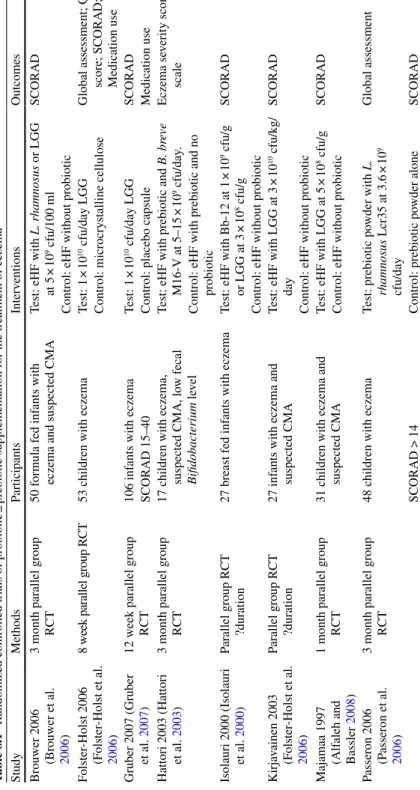
Clinical Crossover Between Nutrition and Dermatology
Introduction
Johnson & Johnson Skin Research Center, CPPW, A Division of Johnson & Johnson Consumer Companies, Inc., Grandview Road 199, Skillman, NJ 08558, ZDA.
Diet and Acne
- Could Certain Essential Nutrients Affect Acne?
- Could Diet Affect Acne Status?
- Status and Studies
- Conclusion
- Introduction
On the other hand, recent clinical studies have suggested a fairly close relationship between diet and acne (Smith et al. 2007a, 2008). The susceptibility of keratinocytes to the antiproliferative effects of vitamins A and D has been documented (Popadic et al. 2008). On the other hand, intake of high levels of omega-3 fatty acids is associated with decreases in inflammatory factors (James et al. 2000).
This conclusion is consistent with the latest studies (Smith et al. 2007a, 2008) on low-glycemic diets (discussed later). The work of Smith et al. 2007a, 2008) focused on the glycemic load, insulin sensitivity, hormonal mediators and acne.
Glycemic Load and Acne
Acne Pathophysiology: Could Acne Be a Metabolic Disease?
A review of data over the past few years suggests an increasing prevalence of acne in people over the age of 25, particularly women (Goulden et al. 1997). Insulin and IGF-I can also inhibit hepatic SHBG production (Singh et al. 1990), increasing the concentration of androgens that are bioavailable. Acne clinically appears during puberty, which is a transitional period of normal insulin resistance (Bloch et al. 1987; Moran et al. 1999).
Even before puberty, hyperinsulinemia has been found to predict the occurrence of acne in later years (Miller et al. The absence of acne in older, obese adults may be due to the fact that during puberty, insulin resistance and acne are inextricably linked to the growth hormone/IGF-I axis (Deplewski and Rosenfield 1999; Moran et al. 2002a).
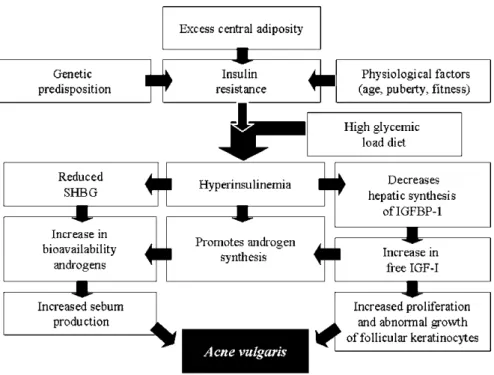
Secular Trends of Advancing Pubertal Age and Acne
Fluctuations in the incidence of acne during the normal life cycle appear to coincide with changes in insulin sensitivity, with insulin resistance also observed during pregnancy, menstruation, and menopause (Homko et al. Clinical observation suggests that insulin resistance is the underlying feature of PCOS . as it generally precedes and causes hyperandrogenism (Dunaif et al. 1989). Furthermore, decreasing insulin secretion and/or increasing insulin sensitivity by pharmacological interventions (eg, acarbose and metformin, respectively) decreases severity of acne symptoms in individuals with PCOS (Ciotta et al. 2001;
However, in obese hyperinsulinemic adults, there is a negative correlation between adiposity and GH levels (Pijl et al. 2001; Luque and Kineman 2006). Obese individuals not only have low basal GH output, they exhibit blunted responses to all recognized GH stimuli, including fasting, acute exercise, GH-releasing hormone, and insulin tolerance testing (Luque and Kineman 2006; Williams et al.
Evidence for a Role of Diet?
Clinical Evidence of a Therapeutic Effect of Low Glycemic Load Diets in Acne Vulgaris
A recent randomized controlled trial found that a low glycemic load (GL) diet that mimics the diet of acne-free populations can alleviate acne symptoms and hormonal markers of acne. Compared to controls, participants on the low-GL diet showed significant improvements in insulin sensitivity and hormonal markers of acne (increases in SHBG and IGFBP-1, indicating reduced bioavailability of testosterone and IGF-I) (Smith et al. 2007b ). This suggests that weight loss mediated the reduction of insulin resistance and associated hyperinsulinemia, which may be important in the clinical regression of acne.
These clinical observations may form a basis for future nutritional recommendations in the treatment of acne. It has yet to be objectively determined whether weight loss is the most important factor in the clinical relief of acne.
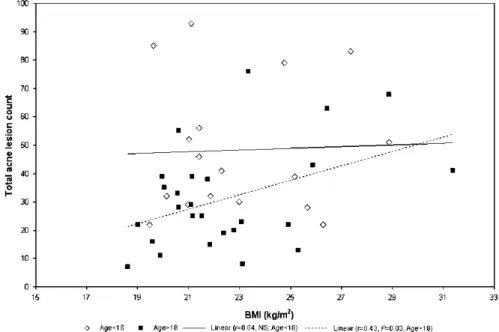
Abnormalities in the Stratum Corneum in Atopic Dermatitis
- Atopic Dermatitis and Impaired Barrier
Essential Fatty Acids and Atopic Dermatitis
- Atopic Dermatitis and Aberrations in Stratum Corneum Structure and Function
- Importance of Omega-6 EFA in Atopic Dermatitis
- Effect of Omega-6 EFAs on Atopic Dermatitis
- Introduction
Finally, the lipid component of the SC barrier is reduced with age and with the seasons (Rogers et al. 1996). In the absence of the LPP, a short periodicity phase (SPP) dominates (Bouwstra et al. 1998; Bouwstra and Ponec 2006). A significant thinner was SC was reported in the presence of these extra enzyme activities (Voegeli et al. 2009).
Mutations in the serine protease inhibitor Kazal type 5 (SPINK5) gene, which encodes the lymphoepithelial Kazal type 5 serine protease inhibitor (LEKTI), have been associated with NS (Kato et al. 2003). In the AD animal model reported by Man et al. 2008), serine protease activity occurred throughout the SC.
Hair Biology and Nutritional Influences
- Healthy Hair
- Hair Biology
- Influence of Age, Sex, and Ethnicity
- Influence of Adipose Tissue
- Apoptosis and Hair Health
- Stress
- Circulation and Perfusion of Nutrients
- Hair Fiber Stress
- Influence of Pharmaceutical Drugs and Herbal Extracts
- Disease and Inflammation
- Historical Link Between Hair and Nutrition
- Hair Color
- Protein and Amino Acids
- Androgens, Insulin Resistance, and Lipids
- Trace Elements
- Lipophilic Vitamins
During the anagen phase, the hair follicle is at its longest and extends deep into the dermal layer of the skin. Photochemical damage to the hair includes breakdown and loss of hair proteins as well as breakdown of melanin in the hair. One of the most troublesome in terms of emotional stress is hair loss due to chemotherapy.
Dysregulation of the hair follicle is also noted in a plethora of inflammatory conditions, particularly alopecia areata. In addition, there are changes in the production of the hair that make it less curly, depigmented and fragile to mechanical stress.
